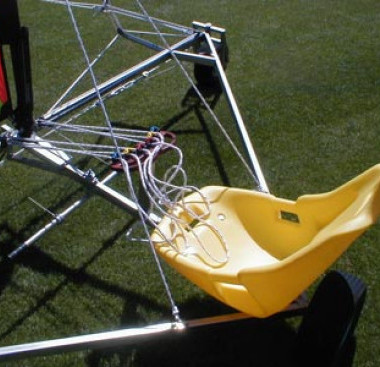Palindrome - the land proa
Chris Luomanen describes the world’s first and only proa on wheels!
The land proa was a mad last minute dash to the finish for 2 quarters worth of thesis work I did around "Joy Rides". The idea was to create unexpected experiences—things you had to try to understand. All of these were developed as working prototypes. The projects included:
Centipede Board: a skateboard with 11 fixed roller blade wheels on the bottom that you turned by leaning into the turn, as usual, but you decreased the radius of your turn by shifting your weight back, the way you step on the tail of a surf board.
The Devil’s Shopping Cart: a dolly with a steering wheel in the middle, that became harder to control the more you tried to control it.
The Human Catapult: a human catapult that scared the bajesus out of people, and then tossed them a few feet.
Palindrome—a Land Proa: I was trying to figure out what I was going to make for my last project, with just two weeks until we had to be done with projects. I decided to go to Ocean Beach in San Francisco (where I live) and just think. I had been thinking a lot about kite buggies, and sailing on the sand. But there is just a small area that is washed by the waves, right on the shore, where the sand is stiff enough to go fast on. It occurred to me that this was a killer app for proas. You don’t have to make a U-turn to tack. You just beam reach down the length of the beach, get to the end, shunt and go back up the beach. I drove home and started laying it out in blue tape on my dining room floor. I designed it in a week, and spec’ed all of the parts (god bless McMaster-Carr) and built it in a week. The frame is all stainless steel, and all of the hardware (except the bolts that hold the seat down and the Teflon coated steel bushings in the headsets) is either stainless, aluminum.
I decided to go weight to windward, it is a speed machine after all! The layout was one fixed wheel to windward, and two counter steering (just like counter steering rudders) wheels to leeward. You steer with bar operated by foot. The whole steering system was connected by cables in tension—for easy adjustment of steering ratios and a bunch of other stuff I couldn’t guess in advance. So whichever tack you were on, pushing with your back leg headed up. I found this comforting, because it felt like using a tiller extension—that made sense to me. The idea was that at maximum speed, the windward wheel would lift, and it would ride on the two steering wheels (a feat my fat ass never achieved, but a friend of mine did) For a rig, I used a 5m windsurfer rig that I got for $100. I had control lines for canting the rig (the fore and aft stays, rigged 6:1), two mainsheets each with fine (6:1) and coarse (2:1) adjustments. The coarse was for shunting. The fine was for playing the main. So there were 6 control lines total on the console—which in a moment of sleepless fetishism is made of blood-wood (rare red rosewood—it was pretty!).
Much to my amazement, it worked right away. I saw 26mph (by GPS) in about 12kts of wind at the rutted field that passes for the Shoreline Amphitheater parking lot—right next to Moffet Field. Something that I hadn’t expected was how important canting the rig was. With the rig centered, it would just sit there. Cant the rig forward (for whichever tack) and the thing would take off! Under way your could cant the rig back, and see TONS of dust smoke coming off of the back tire, until you slowed to a stop. Shunt the rig, and it slowed down pretty fast. But my preferred method for slowing it down was to spin it. The steering control was really great.
One day I ran into another guy with a land sailer—a Manta. I remember seeing these things at the boat show when I was a kid. Its MUCH smaller than my contraption (which has a 12’ wheel base!) and made of aluminum (I didn’t feel like I had enough experience welding aluminum at the time). In a straight line, my bigger rig and weight to windward made my machine an easy winner. If there was any tacking involved, the proa was hosed. That’s when I realized how impractical shunting really is. I did end up sailing it at the beach. And next time I would wear a wet suit, as I froze driving it through the water. But it was very much what I imagined the day I came up with the idea.
What would I improve? The rig canting needs to happen MUCH faster. I envision a lever that you just flip one way or the other. The mast, stayed at the point where the wishbone boom intersects it, was far too flexible. So was the U-joint at the bottom of the mast. Other than that, she amazed me with her speed, comfort and maneuverability. I was never scared or surprised by her manners—but I will tell you that 26mph on a bumpy field with your butt 10" off the ground is more exciting than it sounds!
Anyway, after using it maybe 7 or 8 times, it went into storage in my garage. And that was about 4 years ago. It’s no coincidence that my kid is 3. I spent about $1500 and the two most intense weeks of my life building it. And I am looking for a good home for Palindrome. Somebody has got to take her to burning man!




